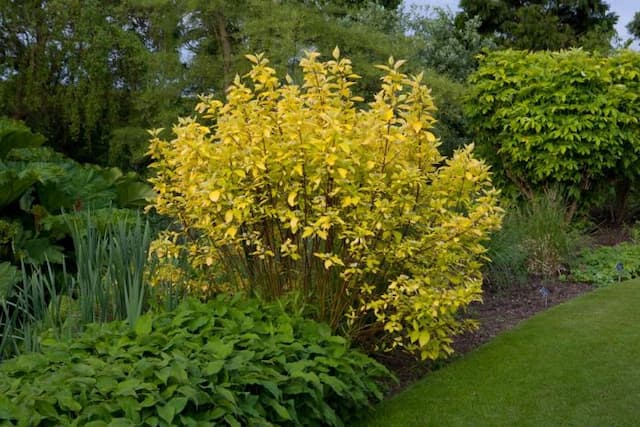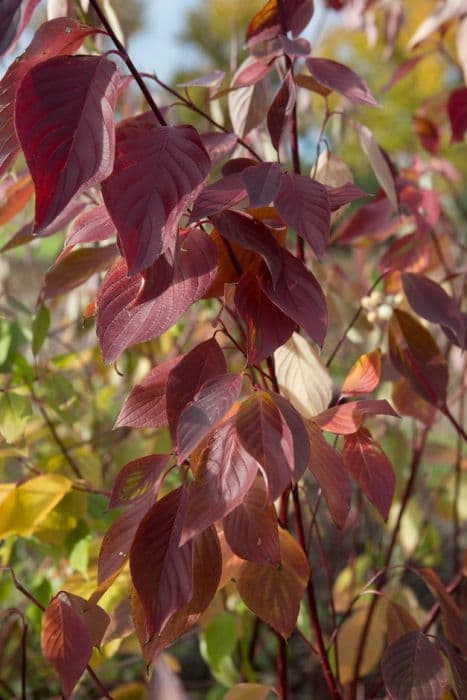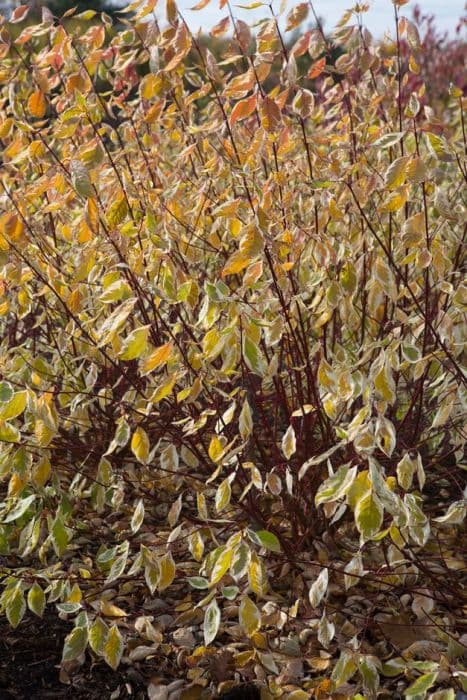Red Twig Dogwood Cornus sericea 'White Gold' (v)

ABOUT
Cornus sericea 'White Gold', commonly known as the 'White Gold' red twig dogwood, is a distinctive ornamental shrub that is widely admired for its striking variegated foliage and vivid stem color. The leaves of this dogwood are characterized by a bright green center surrounded by a bold white margin, creating a striking contrast against the rich greenery of a garden setting. During the flowering season, the plant is adorned with clusters of petite white flowers, which add to its ornamental appeal and provide a soft accent among the variegated leaves. As the seasons transition to autumn, the 'White Gold' red twig dogwood undergoes a remarkable transformation; the leaves develop warm shades before falling, which unveils the plant's signature feature: the bare stems. These stems possess a lively red color that is especially conspicuous against the backdrop of a snowy landscape, making the plant an exceptional choice for winter interest in the garden. In addition to its decorative attributes, the 'White Gold' red twig dogwood produces small, bluish-white fruit that can attract various bird species, lending an ecological benefit by supporting local wildlife. The combination of its seasonal transformations and the year-round visual interest it establishes ensures that the 'White Gold' red twig dogwood is a sought-after selection for gardeners aiming to enhance the aesthetic diversity of their outdoor spaces.
About this plant
 Names
NamesFamily
Cornaceae
Synonyms
White Gold Red Twig Dogwood, White Gold Dogwood, Variegated Red-Osier Dogwood
Common names
Cornus stolonifera 'White Gold', Swida sericea 'White Gold'.
 Toxicity
ToxicityTo humans
Red Osier Dogwood is not commonly listed as a toxic plant to humans. However, as with many plants, it's always best to be cautious and avoid ingestion since individual sensitivity can vary. The ingestion of plant parts is not typically associated with serious poisoning. If accidental ingestion occurs and any adverse symptoms are observed, it is advisable to seek medical attention.
To pets
Red Osier Dogwood is generally considered to be non-toxic to pets. However, the individual sensitivity of pets can vary, and consuming plant material can sometimes result in mild gastrointestinal upset. If a pet consumes Red Osier Dogwood and displays symptoms such as vomiting or diarrhea, it is recommended to consult with a veterinarian.
 Characteristics
CharacteristicsLife cycle
Perennials
Foliage type
Deciduous
Color of leaves
Variegated
Flower color
White
Height
6 feet (1.8 meters)
Spread
5 feet (1.5 meters)
Plant type
Shrub
Hardiness zones
3
Native area
North America
Benefits
 General Benefits
General Benefits- Attractive Foliage: Cornus sericea 'White Gold' offers striking variegated leaves that can add visual interest to any garden space.
- Wildlife Support: It can provide food and habitat for birds and other wildlife, enriching local biodiversity.
- Seasonal Interest: This plant showcases flowers in spring and colorful stems in the winter, offering year-round garden interest.
- Erosion Control: With its extensive root system, this plant can help stabilize soil and prevent erosion on slopes.
- Low Maintenance: Once established, it requires minimal care, making it a practical choice for busy gardeners.
- Habitat Restoration: It's useful in restoring native habitats and landscapes, promoting ecological balance.
- Pollinator-Friendly: The flowers can attract and support pollinators such as bees and butterflies.
 Medical Properties
Medical PropertiesThis plant is not used for medical purposes.
 Air-purifying Qualities
Air-purifying QualitiesThis plant is not specifically known for air purifying qualities.
 Other Uses
Other Uses- Wildlife Habitat: The dense foliage provides excellent cover and nesting sites for birds and small mammals.
- Ink and Dye Source: Native Americans historically used the bark to make a scarlet dye for textiles and as a component in inks.
- Photography: With its striking variegated leaves and red stems, this plant is excellent for garden photography, particularly in winter.
- Livestock Forage: Although not a primary food source, when other resources are scarce, livestock may forage on the leaves and twigs.
- Winter Interest: The brightly colored stems provide visual interest in the garden during the gray winter months.
- Erosion Control: Due to its spreading habit and root system, it is useful for stabilizing soil on slopes and riverbanks.
- Craft Materials: The flexible stems can be used in basketry and for crafting wreaths and other decorative items.
- Water Filtration: It can be incorporated into rain gardens or buffer strips to help filter runoff water before it enters waterways.
- Garden Structure: The stems can be left unpruned to add structural interest to gardens in the dormant season.
- Tool Handles: Historically, stronger wood species from the Cornus family have been utilized in making tool handles.
Interesting Facts
 Feng Shui
Feng ShuiThe Red Osier Dogwood is not used in Feng Shui practice.
 Zodiac Sign Compitability
Zodiac Sign CompitabilityThe Red Osier Dogwood is not used in astrology practice.
 Plant Symbolism
Plant Symbolism- Stability and Strength: Cornus sericea, commonly known as Red Osier Dogwood, often symbolizes stability and strength due to its sturdy wood and resilience in various growing conditions.
- Perseverance: With its ability to thrive in tough environments, Red Osier Dogwood represents perseverance and the ability to endure challenges.
- Protection: In some cultures, Dogwood trees are thought to offer protection due to their dense growth, which provides shelter for wildlife.
- Renewal: The prolific spring growth and flowering of Red Osier Dogwood signify renewal and the promise of new beginnings.
- Hope: The bright blooms and rejuvenation after winter associate Red Osier Dogwood with hope and the anticipation of joy.
 Water
WaterRedtwig dogwood 'White Gold' typically requires regular watering to maintain moist, but not soggy, soil conditions. It’s advisable to provide deep watering once a week, ensuring that you add an equivalent of 1 to 1.5 gallons of water per plant for proper soil penetration. During hot and dry periods, the frequency may need to increase to twice per week, with less water required during cooler or rainy spells. It's crucial to avoid overwatering, as this can lead to root rot. Adjust water amounts based on rainfall and check the soil moisture before watering to ensure it has begun to dry out.
 Light
LightRedtwig dogwood 'White Gold' flourishes best in full sun to partial shade. It's ideal to plant it in a location that receives at least 4 to 6 hours of direct sunlight daily, but also can perform well when it receives dappled sunlight throughout the day. Avoid deep shade as it can hinder the plant's growth and vibrant foliage color.
 Temperature
TemperatureRedtwig dogwood 'White Gold' is cold-hardy and thrives in a temperature range between 50°F and 75°F. It can survive winter temperatures down to -30°F, while excessive heat above 95°F should be avoided as it can stress the plant. Providing a location with some afternoon shade could be beneficial in warmer climates to prevent overheating.
 Pruning
PruningPruning redtwig dogwood 'White Gold' can enhance its appearance and health. Prune in late winter to early spring before new growth starts. Remove a quarter to a third of the oldest stems to stimulate new growth and maintain vibrant stem color. Additionally, prune out any dead, damaged, or crossing branches to maintain a neat form. Regular pruning also encourages the growth of the colorful young stems that are a standout feature in the winter landscape.
 Cleaning
CleaningAs needed
 Soil
SoilRed Osier Dogwood 'White Gold' prefers well-drained, fertile soil rich in organic matter. A soil mix of loam, sand, and peat with some compost provides an ideal environment. The soil pH should be between 5.5 and 7.5 for optimal growth.
 Repotting
RepottingRed Osier Dogwood 'White Gold' is typically grown outdoors and does not require frequent repotting. However, if grown in containers, repot every 2-3 years to refresh the soil and provide room for growth.
 Humidity & Misting
Humidity & MistingRed Osier Dogwood 'White Gold' tolerates a wide range of humidity levels and thrives in average outdoor humidity.
 Suitable locations
Suitable locationsIndoor
Place Red Osier Dogwood 'White Gold' near a bright window.
Outdoor
Plant in moist, fertile soil with access to full sun or part shade.
Hardiness zone
3-8 USDA
 Life cycle
Life cycleCornus sericea 'White Gold', commonly known as Red Osier Dogwood, starts its life cycle with seed germination, occurring when conditions of moisture and temperature are favorable. Seedlings emerge and grow into juvenile plants, developing a characteristic golden-variegated foliage amidst green. As saplings mature, they become hardy shrubs typically reaching up to 6-9 feet tall with multiple stems and a spread to match their height. The growth stage includes the formation of white blooms in late spring to early summer, followed by the production of white to blueish fruit. In autumn, leaves may turn to a mix of orange, red, and purple hues before falling off as the plant enters dormancy for the winter. In its perennial cycle, the Red Osier Dogwood will resume growth from its root system once the conditions in spring are conducive, continuing this process for many years, often upwards of 20 years or more with proper care.
 Propogation
PropogationPropogation time
Late Winter-Early Spring
The Cornus sericea 'White Gold', commonly known as the Variegated Red Twig Dogwood, is most commonly propagated by softwood cuttings. This method involves taking cuttings from new growth in late spring to early summer when the stems are mature enough to snap when bent. The cuttings should be about 4 to 6 inches (approximately 10 to 15 centimeters) in length, and the lower leaves are removed. The cut end is often dipped in a rooting hormone to encourage root growth and then placed in a well-draining potting mix. The pot should be kept in a warm environment with high humidity, such as under a plastic dome or in a greenhouse, and the soil should be kept consistently moist. Roots typically develop within a few weeks, after which the new plants can eventually be transplanted outdoors.

![Dogwood [Baton Rouge]](/_next/image?url=https%3A%2F%2Fplants-admin.emdemapps.com%2Fimages%2Fplants%2F%2Fimages%2F604b59cf0fefd.png&w=640&q=75)


![Dogwood [Ivory Halo]](/_next/image?url=https%3A%2F%2Fplants-admin.emdemapps.com%2Fimages%2Fplants%2F%2Fimages%2F604b535cbcb9a.png&w=640&q=75)




